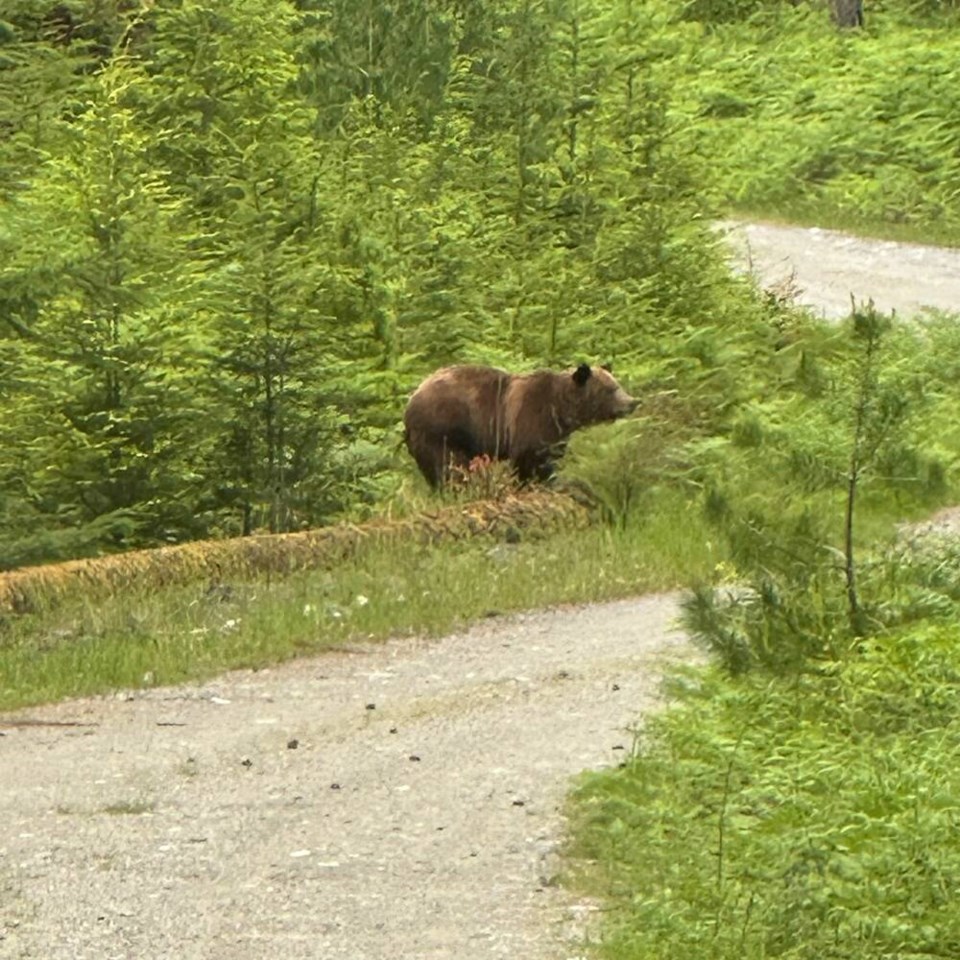A secret plan to trap and relocate the grizzly on Texada Island might have worked if not for delays getting the equipment and people in place, says the man behind the effort.
Erik Blaney, manager of resources and lands for the shishálh First Nation, based in Powell River, said it took several days to secure the right bear trap and to bring in trackers. He said the whole plan had to be kept quiet to ensure the trap’s location would not be compromised.
Blaney said the trap was set to be sent from Kamloops on Tuesday, and the bear’s movements were being monitored to place it.
On Monday night, however, the B.C. Conservation Officer Service heard from the RCMP that the bear had been shot and wounded by a resident. The animal was found dead on Tuesday at the north end of the island.
“It was a good plan — everybody was on standby, the trap was on its way, helicopter on standby,” said Blaney. “So I’m very frustrated and angry that I didn’t get a chance to complete the plan.”
The five-year-old grizzly, dubbed Tex by locals, had been on Texada since late May, when it swam over from Powell River. It had the small island of about 1,200 people living on edge amid reports that it had been stalking people and livestock.
Prior to news of the bear’s death, the Homalco, Tla’amin and shishálh First Nations were in talks with the province to relocate the grizzly to a remote spot in Homalco territory in Bute Inlet. The province had initially resisted any translocation because the bear had been trapped and relocated twice before on the Sunshine Coast.
Randene Neill, minister of Water, Lands and Natural Resources, later agreed to the plan, Blaney said, but the decision was kept under wraps while logistics were being worked out.
Some Texada residents said the province should have warned them of a relocation plan, saying the bear might have survived if everyone had known it was going to be moved.
“It brings me to tears thinking if only the information had been out there,” said Sandy McCormick, who lives on the west side of Texada and represents the island on the qathet Regional District Board.
McCormick said islanders have long enjoyed a “predator-free environment” without bears or cougars, but many had been looking over their shoulders in recent weeks.
“There’s a great feeling of sadness that he came to the end as he did, that someone took it upon themselves to take the law into their hands and end his life,” she said. “I know a lot of people were really rooting for him. But some people were certainly fearful of the fact that he was present.”
McCormick had her own encounter with the grizzly while weeding her garden.
“My husband sort of yelled at me from the house and was pointing, and I looked up and saw [the grizzly] about 40 feet away,” she said.
“And he was beautiful. His fur just glistened in the sunlight. He was majestic, very healthy-looking. Of course, not being bear-aware, I just ran into the house. But he didn’t follow me. He didn’t chase me.
“He just took off and went down to the beach and just carried on his way.”
Like McCormick, Susan McLeod, who lives with her husband and children on Texada part-time, said the minister should have let people in on the relocation plan. “I suspect everyone involved would have preferred to have the grizzly relocated.”
But she said the only information the province provided residents, via Facebook, was that the bear was not a candidate for relocation.
While the grizzly roamed Texada’s farms, parks and residential neighbourhoods for six weeks, McLeod said the province only provided tips for “coexistence, like bringing pet food indoors.”
McLeod said families had been collectively holding their breath, hoping no one would be hurt or killed because the summer population swells with tourists and campers.
“The island is small, and conflict seemed inevitable,” said McLeod. “While I did not want to see this bear killed, he truly did not belong there.”
In an interview on CBC Radio, Neill said the three First Nations came up with a “really robust, clear plan about how they wanted to translocate [the grizzly] … after talking to all our specialists, our team, we agreed.”
Blaney said the First Nations reminded the province that the shishálh and Tla’amin First Nations are self-governing entities who have modern treaties and historic land-management agreements.
“They couldn’t make arbitrary decisions without us … the decision needs to be made by self-governing nations,” said Blaney. “Changing [Neill’s] mind wasn’t hard. I think it was folks that were just below her that had a hard time changing their minds.”
Blaney said securing the right bear trap took time. The helicopter available to First Nations was only able to carry 1,000 pounds, and the only trap that would work was in Kamloops.
He said the plan had to be kept secret because it was clear from sentiments being expressed on a Texada Facebook group that “about 30%” of islanders wanted the bear dead. “So when we’re dealing with stats like that, we have to be mindful of bear safety.
“We had to consider that people could tamper with the trap, create scent around the area where the trap was deployed.”
Blaney said while First Nations are disappointed in the outcome, they have learned from the experience. He said grizzlies will likely continue expanding their territories, including swimming over to the smaller islands.
“We need to take these lessons learned back to the natural resource tables and figure out a process that’s much faster,” he said. “We need to figure out training, where our First Nations Guardians can have bear rescue training certifications. We have to train response teams and develop our own traps, and continue to study and understand these bears.
“I think before we shoot, we have to look at how we can help them adapt.”



